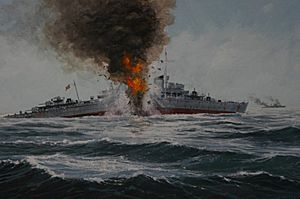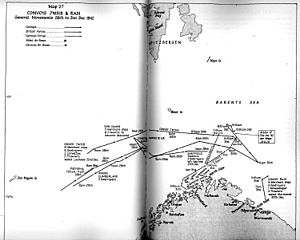Battle of the Barents Sea facts for kids
Quick facts for kids Battle of the Barents Sea |
|||||||
|---|---|---|---|---|---|---|---|
| Part of World War II | |||||||
 Battle of the Barents Sea, Erwin J. Kappes (sinking of the Friedrich Eckholdt) |
|||||||
|
|||||||
| Belligerents | |||||||
| Commanders and leaders | |||||||
|
|||||||
| Strength | |||||||
| 2 light cruisers 6 destroyers 2 corvettes 1 minesweeper 2 trawlers |
2 heavy cruisers 6 destroyers |
||||||
| Casualties and losses | |||||||
| 250 killed 1 destroyer sunk 1 minesweeper sunk 1 destroyer damaged |
330 killed 1 destroyer sunk 1 heavy cruiser damaged |
||||||
The Battle of the Barents Sea was an important naval battle during World War II. It happened on December 31, 1942, in the freezing Barents Sea, which is part of the Arctic Ocean. This fight was between ships from the German Navy and British ships. The British ships were protecting a group of supply ships, called a convoy, heading to the USSR.
The battle took place north of North Cape, Norway. The German ships failed to cause much damage to the convoy. This made Adolf Hitler very angry. After this battle, he decided that the German Navy should focus more on its U-boat (submarine) fleet instead of its large surface ships.
Contents
Why the Battle Happened
The Convoy: JW 51B
During World War II, the United Kingdom sent vital supplies to the USSR to help them fight Germany. These supplies traveled by sea in groups called convoys. Convoy JW 51B was one such group. It had fourteen merchant ships carrying many important war materials. These included tanks, vehicles, fighter planes, bombers, and thousands of tons of fuel and other supplies.
To protect these valuable ships, the convoy had an escort of warships. This escort included six destroyers: HMS Achates, Orwell, Oribi, Onslow, Obedient, and Obdurate. There were also two smaller ships called Flower-class corvettes (HMS Rhododendron and Hyderabad), a minesweeper (HMS Bramble), and two trawlers (Vizalma and Northern Gem).
Captain Robert Sherbrooke was in charge of this escort group, sailing on the destroyer Onslow. The convoy sailed in the middle of winter. This was done to avoid attacks from German aircraft, which had caused a lot of damage to earlier convoys. Farther away, two British cruisers, HMS Sheffield and Jamaica, along with two destroyers, were waiting to provide extra protection if needed. This group was led by Rear-Admiral Robert L. Burnett.
German Plan: Operation Rainbow
The German Navy had a plan called Unternehmen Regenbogen (Operation Rainbow). Their goal was to attack the next Arctic convoy. A German force, based in Altafjord in northern Norway, was ready. This force was led by Vice-Admiral Oskar Kummetz, who was on the heavy cruiser Admiral Hipper.
The German fleet was powerful. It included two heavy cruisers: Admiral Hipper and Lützow (which used to be called Deutschland). They also had six destroyers: Friedrich Eckoldt, Richard Beitzen, Theodor Riedel, Z29, Z30, and Z31.
Before the Battle
Convoy JW 51B left Loch Ewe in Scotland on December 22, 1942. It met its escort ships near Iceland on December 25. As they sailed north-east, they faced very strong storms on December 28–29. These storms caused some of the ships to get separated from the main convoy.
When the weather improved, five merchant ships and two escort ships (Oribi and Vizalma) were missing. The minesweeper Bramble was sent to look for them. Three of the lost merchant ships rejoined the convoy the next day. The others continued on their own towards Kola Inlet.
On December 24, a German reconnaissance aircraft spotted the convoy. From December 30, a German U-boat, U-354, followed the convoy. When the German Naval Staff received this information, Admiral Kummetz was ordered to sail immediately to attack the convoy. Kummetz divided his ships into two groups, one led by Admiral Hipper and the other by Lützow.
The Battle Begins
At 8:00 AM on December 31, the main part of Convoy JW 51B was about 120 miles north of Finnmark, heading east. The destroyer Oribi and one merchant ship were separated and did not take part in the fighting. About 15 miles behind the convoy, Bramble was still searching for lost ships. North of the convoy, Vizalma and another ship were about 45 miles away. Rear-Admiral Burnett's cruisers were 15 miles southeast of them, and 30 miles from the convoy.
To the north of the convoy, Admiral Hipper and three destroyers were getting closer. About 50 miles away, Lützow and her three destroyers were approaching from the south. At 8:00 AM, the German destroyer Friedrich Eckholdt spotted the convoy and reported it to Admiral Hipper.
At 8:20 AM, the British destroyer Obdurate spotted three German destroyers behind the convoy. Then, Onslow saw Admiral Hipper, also behind the convoy. Onslow, along with Orwell, Obedient, and Obdurate, steered to intercept the German ships. Achates was ordered to stay with the convoy and make a lot of smoke to hide the merchant ships.
After some shooting, the British ships turned, pretending to launch a torpedo attack. Captain Sherbrooke knew his torpedoes were his strongest weapons, even though he was outgunned. The trick worked: Admiral Hipper temporarily pulled back. Admiral Kummetz had been told not to risk his valuable ships.
Admiral Hipper soon returned for a second attack. It hit Onslow, causing heavy damage and many casualties, including 17 sailors killed. Although Onslow survived the battle, Captain Sherbrooke was badly hurt and lost sight in one eye. Command of the escort then passed to the destroyer Obedient.
Admiral Hipper then moved north of the convoy. It unexpectedly found Bramble, the British minesweeper. There was a short fight, and Admiral Hipper's much bigger guns caused a huge explosion on Bramble. The German destroyer Friedrich Eckholdt was ordered to finish off Bramble, which sank with everyone on board. Admiral Hipper then turned its attention to Obedient and Achates to the south. Achates was badly damaged but kept making smoke to protect the convoy until it finally sank. The trawler Northern Gem rescued many of its crew. The Germans thought they had sunk a destroyer, but they had actually sunk the minesweeper Bramble and damaged Achates.
The sound of the battle attracted the attention of Rear-Admiral Burnett's Force R (the cruisers Sheffield and Jamaica). They approached without being seen and opened fire on Admiral Hipper at 11:35 AM. They hit Admiral Hipper with several shells, damaging two of its boiler rooms and causing some flooding. This reduced its speed. Kummetz first thought the attack was from another destroyer. But when he realized it was two cruisers, he ordered his ships to retreat to the west.
In another case of mistaken identity, the German destroyers Friedrich Eckholdt and Richard Beitzen thought Sheffield was Admiral Hipper. They tried to join up with the British ships. Instead, Sheffield attacked them. Friedrich Eckholdt broke in two and sank with all hands.
Meanwhile, Lützow approached from the east and fired at the convoy, which was still hidden by smoke from the damaged Achates. Lützow then headed north-west to join Admiral Hipper. It also met Sheffield and Jamaica, which opened fire. Both sides decided to stop fighting at the same time, around noon. Each side was worried about torpedo attacks from the other's remaining destroyers. Burnett's Force R continued to follow the German ships from a distance until it was clear they were heading back to their base. The convoy ships then regrouped and continued safely towards Kola Inlet.
A Hero's Medal
Captain Robert Sherbrooke was awarded the Victoria Cross, the highest military award for bravery in the United Kingdom. He said that the medal was really for the bravery of the entire crew of Onslow. In the battle, he was badly wounded and lost the sight in his left eye. Despite this, he returned to active duty and later retired from the navy as a rear-admiral.
Remembering the Battle
The Battle of the Barents Sea is remembered in several ways. At the memorial for the minesweeper Bramble, Captain Harvey Crombie spoke about the crew. He said they had faced incredible difficulties and dangers, but they never gave up. He believed they would want people to praise God for their steadfast duty.
The battle was also the subject of a book called 73 North by Dudley Pope. It was also featured in a poem called JW51B: A Convoy by Alan Ross, who served on the Onslow during the battle.


